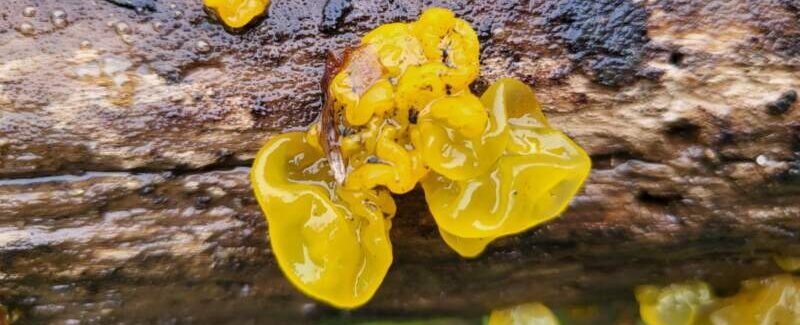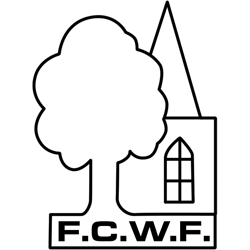The trees of Childwall Woods are justifiably well known for their size, age and splendour, especially in spring when the bluebells are in flower, and the Veteran trees particularly have been well described by Brenda Cameron on the website.
The trees of Childwall Fields are less well known but are surprisingly diverse, with over 50 species of trees to be found here. Most of them are young, only 30 years old, and few are large or impressive. But the magnificent Childwall Woods were young once, the trees mere saplings. If we look after the trees of Childwall Fields, their sheer diversity promises some really splendid mature woodlands in the future.
The history of Childwall Fields
Childwall Fields has an interesting history which is worth knowing before we describe the different areas of the Fields and the trees they contain. As detailed on the History page of the Friends of Childwall Woods and Fields website:
“ the area that we know as Childwall Fields was once known as Childwall Park and was a gentle grassy slope up from Childwall Lane to the border of Childwall Woods. Looking very different to the Childwall Fields that we know today, it had just a few small trees and bushes.
Childwall Park became Childwall Golf Club in 1922 then throughout World War 2 the land known as the fields was used to grow essential food crops. After the war had ended the fields changed again but now to pasture for sheep. Still the gentle slope up to the woods.
In the 1960s the slope disappeared under hundreds of tons of garbage when the area was used as a huge landfill site which continued into the 1970s. Tipping eventually stopped and after burning off as much as possible the site was allowed to settle and the 3 fields we see today were created. The reason for defiling this gentle slope was to create three level areas that could be used by the college as football pitches. The fields were capped with clay and then covered with a layer of soil before being used for a short time as sports fields, but when the college was sold to Lime Pictures, the fields were given back to nature, and an amazing variety of grasses, wildflowers, bushes and trees now cover this site, disguising what lies beneath.
In the 1990s the Fields became the focus of the research done by PhD students from Liverpool John Moores University who took on the challenge of planting a variety of trees to see which species would grow best, if any, on a former landfill site and the mixed plantations on the SE part of the middle and lower fields were created. Childwall Fields was one of 12 former landfill sites in the region that were planted for research purposes and 30 years later has proven to be one of the best. The whole area has now matured into the perfect habitat for a variety of animals, birds, flora and fauna, as well as becoming a wonderful asset to the community.”
Childwall Fields – 4 zones
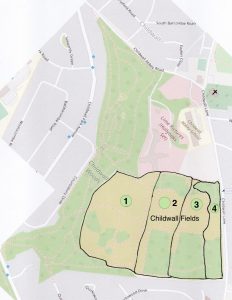
In describing the Trees of Childwall Fields I have divided the Fields into 4 zones (see map). If you wish to explore the lower Fields, please note that access is not easy, paths are narrow with brambles and nettles (shorts are NOT recommended!) and it is frequently muddy underfoot, particularly in winter. The paths are not wheelchair accessible.
1 The Top Field is the largest area and adjoins Childwall Woods and the Lime Pictures studio site. It has the largest area of meadow with 2 areas of planted trees in the middle and the willow plantation to the south. New scrapes and ponds have now been excavated. This is the most accessible of the fields, at least around the edges, and is a favourite with dogwalkers. The middle of the field can be very muddy in winter.
2 The Middle Field runs from the concrete path beside Lime Pictures to the houses on Quickswood Drive. There are woods to the north and south of the field and an area of meadow and newly planted orchard in the middle. It includes also the slope below the Top Field.
3 The Lower Field runs from the concrete path beside the Childwall Abbey School playing fields to the houses on Quickswood Drive. Again, there are woods to the north and south of the field and it includes also the slope below the Middle Field. This is the wildest and least visited field with the middle area of the field a tangle of brambles and nettles.
4 The final area is the Childwall Lane Slope which runs down from the Lower Field to adjoin Childwall Lane. This contains a woodland area on the slope beside the Childwall Lane entrance, plantings along Childwall Lane and an area of mature, well established trees at the southern end, with a large central area of brambles. To explore this area, there are steep paths down from the Lower Field through the woods at the north and south ends.
The Trees of each area
With the exception of a few trees along Childwall Lane and line of tall poplars, none of the trees in any of Childwall Fields are particularly large or mature. But what is impressive is their sheer number and diversity – the result of the experimental planting which was part of the reclamation work of the 1990s. The variety of species of trees is unusual, as the Species List shows.
1 Top Field
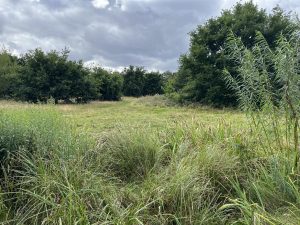
The Top Field feels open after the enclosed space of Childwall Woods but it is actually quite densely planted with trees, many of which are self sown (or planted by jays and squirrels). It feels open because the trees are still quite young and small. Along the boundary with Lime Studios are elder, sycamore, silver birch, blackthorn, hawthorn, and wild cherry. Aspen have been planted, and there is a fine dark leaved cherry plum.
Moving into the north area of the Top Field, you will find stands of oak and silver birch and tall shimmering stands of white poplar. And scattered among these are rowan, blackthorn, common alder, elder, sycamore, horse chestnut, common osier and goat willow. These were planted by Liverpool City Council in the 1990s.
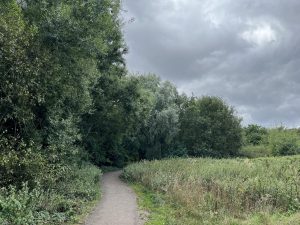
The trees thin out in the middle of the fields where the pond and scrapes have been excavated, then you move into another area of trees with stands of common alder, silver birch, and white poplar, with oak, goat willow, common osier, blackthorn, elder, hawthorn, hazel and field maple. Nearing the willow plantation at the south end of the Top Field a stand of young aspen can be found with a small sweet chestnut. In total nearly 20 species of tree can be found on the Top Field. In the willow plantation there is also groups of larch and hazel.
2 Middle Field
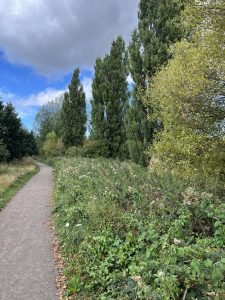
Entering from the concrete path is easiest, hardest is down the steep slope from the Top Field. From Lime Studios path, you enter a small wood under the line of impressive poplars planted along the slope below the Top Field. These landmark trees are all varieties of black poplar. There are four varieties of poplar here – two large, spreading hybrid black poplars, and the columnar shapes of Lombardy and Plantier poplar. The copse contains: oak, elder, sycamore, goat willow, hornbeam, silver birch, rowan, ash and bird cherry.
The Middle Field then opens into an area of meadow and bramble thickets in the central area containing scattered trees: common osier, sycamore, crack willow, silver birch, hornbeam, goat willow, horse chestnut and oak. A small European silver fir can also be found – perhaps a Christmas donation?
Recently an orchard containing a variety of fruit trees has been planted including: apples, pears, plums and greengages.
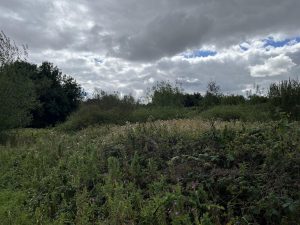
The plantation at the lower end of the Middle Field contains over 20 species of tree, predominantly ash, with stands of white willow, red oak, sliver birch, common osier, holly and blackthorn. Most of the trees are 10-15m high. In addition, sycamore, horse chestnut, oak, elder, hawthorn, rowan, wild cherry and bird cherry can be found, along with narrow-leaved ash, apple, field maple, goat willow, pine and common alder. A weeping willow can also be seen bordering the houses at the south end.
3 Lower Field
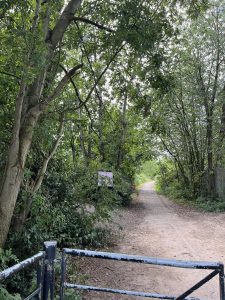
Entering from the concrete path, you are met by a small copse with wild cherry, common lime, goat willow, elder, oak, ash, hawthorn, common osier and silver birch. The copse continues up the slope towards the Middle Field, with an understorey containing privet and dog rose. Scattered trees continue along the slope: birch, wild cherry, bird cherry, elder, hawthorn and holly. At the base of slope as the field opens out is a fine dark leaved cherry plum.
In the middle of the bramble patch are scattered elder, oak, hawthorn and sycamore and on the edge of the bramble area above the Childwall Lane Slope is a fine Swedish whitebeam and a dense, rounded English oak.
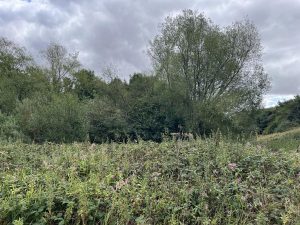
The plantation at the south end of the Lower Field is a densely planted area of smallish trees a uniform 10 -15m in height. Your first sight is a wall of willows – white willows and the smaller common osier – with red oak, elder, ash and sycamore. Continuing into the plantation reveals a surprising matrix of trees planted in small stands: birch, Austrian pine, oak, bird cherry, rowan, and sycamore. This patchwork continues with hawthorn, common lime, wild cherry, then groves of ash, red alder, hazel and hornbeam. And amid these are single apple, larch, horse chestnut, holly, yew and blackthorn trees. Then, screening the houses, are cypress and laurel trees. It’s an extraordinary mix of at least 27 species in one small plantation. Some of the trees such as red alder were used in reclamation plantings which accounts for their use here on this old landfill site
4 Childwall Lane Slope
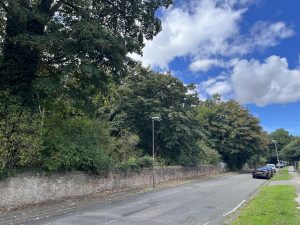 Approaching the Childwall Woods and Fields site from the south east along Childwall Lane, you immediately see some large mature trees – common lime, sycamore, and beech – which have survived the turbulent history of the Fields. Behind and beneath these large trees are hazel, oak, rowan, holly, and hornbeam. This is the oldest hedgerow on the site consisting mostly of hawthorn.
Approaching the Childwall Woods and Fields site from the south east along Childwall Lane, you immediately see some large mature trees – common lime, sycamore, and beech – which have survived the turbulent history of the Fields. Behind and beneath these large trees are hazel, oak, rowan, holly, and hornbeam. This is the oldest hedgerow on the site consisting mostly of hawthorn.
Continuing along Childwall Lane, English oak, small leaved lime, aspen, and balsam poplar appear, with an under-storey of elder, hawthorn, hazel and manna ash.
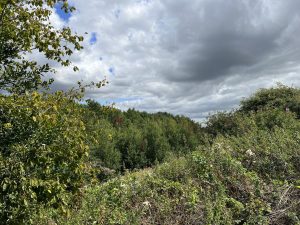
Entering the site from Childwall Lane beside the school playing fields, past two fine ash trees, brings an immediate surprise – the small woodland area on the left slope is so diverse! There are over twenty species of trees here – ash, sycamore, balsam poplar, horse chestnut, English oak, wild cherry, hazel, holly, beech, elder, hawthorn, common lime, common osier, grey willow, Guelder rose, wayfaring tree, birch, goat willow and hornbeam. But the pick of the bunch, set back just on the left of the entrance, is a small group of fine variegated sycamores. The large stand of aspen is best seen looking down the Slope from the Lower Field above.
Most of the lime trees in the CWF reserve are common lime, so it’s interesting to find two mature small leaved limes in this lowest part of the site. The pollen records show that small leaved lime is among our oldest and most important native trees and 5000 years ago it was a dominant species in the ancient wood-pasture that covered this island. There is also a small grove of Wych elms.
The Trees of Childwall Fields – Species List
(n. = native to GB)
Over 2500 species of tree can be found in Britain but only 35 of these are native, that is, these trees were able to persist here during the last Ice Age, or were able to migrate north before sea level rose and the English Channel was formed 6000 years ago. An impressive 25 of Britain’s 35 native trees can be found here at Childwall Fields.
Common name |
Botanical name |
Field |
| Common Ash n. | Fraxinus excelsior | 1 2 3 4 |
| Narrow-leaved Ash | Fraxinus augustifolia | 3 |
| Manna Ash | Fraxinus ornus | 4 |
| Alder n. | Alnus glutinosa | 1 2 3 |
| Red Alder | Alnus rubra | 3 |
| Aspen n. | Populus tremula | 1 4 |
| Apple, crab n. | Malus sylvestris | 3 |
| Apple, domestic | Malus x domestica | 3 |
| Beech n. | Fagus sylvatica | 4 |
| Silver Birch n. | Betula pendula | 1 2 3 4 |
| Blackthorn n. | Prunus spinosa | 1 2 3 |
| Hybrid Black Poplar ‘Robusta’ | Populus x canadensis ‘Robusta’ | 1 4 |
| Bird Cherry n. | Prunus padus | 2 3 |
| Wild Cherry n. | Prunus avium | 1 2 3 |
| Cherry Plum | Prunus cerasifera ‘Nigra’ | 1 3 |
| Lawson cypress | Chamaecyparis lawsoniana | 3 |
| Elder n. | Sambucus nigra | 1 2 3 4 |
| Wych Elm n. | Ulmus glabra | 4 |
| Field Maple n. | Acer campestre | 1 2 |
| Silver Fir | Abies alba | 2 |
| Guelder Rose | Viburnham oculus | 3 |
| Hazel n. | Corylus avellana | 1 3 |
| Hawthorn n. | Crataegus monogyna | 1 2 3 4 |
| Holly n. | Ilex aquifolium | 2 3 4 |
| Hornbeam n. | Carpinus betulus | 2 3 4 |
| Horse Chestnut | Aesculus hippocastanum | 1 2 3 4 |
| Common Lime | Tilia x europea | 2 3 4 |
| Small leaved lime n. | Tilia cordata | 1 4 |
| Larch | Larix decidua | 1 3 |
| Bay Laurel | Laurus nobilis | 3 |
| English Oak n. | Quercus robur | 1 2 3 4 |
| Red Oak | Quercus rubra | 2 3 |
| Austrian Pine | Pinus nigra | 2 3 |
| Scots Pine n. | Pinus sylvestris | 2 3 |
| White poplar | Populus alba | 1 |
| Hybrid Black poplar | Populus x canadensis | 1 2 |
| Lombardy poplar | Populus nigra ‘Italica’ | 2 |
| Plantier poplar | Populus nigra v ‘Plantierensis’ | 2 |
| Dog rose | Rosa canina | 1 2 |
| Rowan n. | Sorbus aucuparia | 1 2 3 4 |
| Sycamore | Acer pseudoplatanus | 1 2 3 4 |
| Variegated sycamore | Acer pseudoplatanus v variegatum | 4 |
| Goat willow n. | Salix caprea | 1 2 3 4 |
| Grey willow | Salix cinerea | 4 |
| Crack willow n. | Salix fragilis | 2 |
| Common osier n | Salix viminalis | 1 2 3 4 |
| White willow n. | Salix alba | 1 2 3 |
| Weeping willow | Salix babylonica | 2 |
| Swedish whitebeam | Sorbus intermedia | 3 |
| Wayfaring tree | Viburnum lantana | 4 |
| Yew n. | Taxus baccata | 3 |
Birds of Childwall Fields
The variety of vegetation of Childwall Fields with their matrix of woods and open areas supports a different birdlife from that found in Childwall Woods and this contributes to the overall biodiversity of the nature reserve, and hence its importance.
Some birds can be found throughout the reserve in both woods and fields: blackbird, song thrush, robin, great tit, blue tit and long tailed tit, carrion crow, and wood pigeon for example.
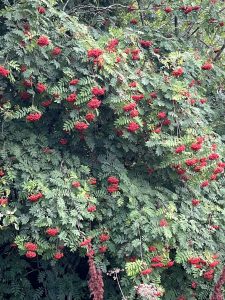 Other birds definitely prefer the Fields – magpies for example are here in their dozens. Generally there are more finches and warblers in the Fields and the abundance of berries and cherries here supports winter visitors such as redwings, a type of thrush. The stands of birch and alders on the Top Field are important in providing seeds as winter food for finches including goldfinch, siskin and, recently, redpoll.
Other birds definitely prefer the Fields – magpies for example are here in their dozens. Generally there are more finches and warblers in the Fields and the abundance of berries and cherries here supports winter visitors such as redwings, a type of thrush. The stands of birch and alders on the Top Field are important in providing seeds as winter food for finches including goldfinch, siskin and, recently, redpoll.
And in spring cherry blossom and catkins on alder, willow and hazel are important to bullfinches. In spring listen for the song of dunnocks among the brambles, and for blackcaps, chiffchaffs, wrens and greenfinch, and sometimes willow warblers, which like trees near open areas.
Amid the brambles and along the slopes are trees which are used as ‘singing posts’ by warblers such as whitethroat, and finches such as linnets and goldfinches, especially on the the Lower and Middle Fields.
The mature trees of Childwall Lane Slope area are home to jay, wood pigeon, crow, nuthatch and greater spotted woodpecker, and in this way are similar to Childwall Woods.
Above the plantations of the Lower and Middle Fields, look for the resident buzzards (often being mobbed by crows and magpies!). In winter, mixed flocks of tits, treecreepers and goldcrests can be found in these woods.
Kestrels can be seen hovering over the Top and Middle Fields, and sparrowhawks hunt here too.
It will be exciting to see what new species appear drawn by the pond and scrapes of the Top Field. Mallards have already made a few exploratory visits.
**********
Andrew Scott
